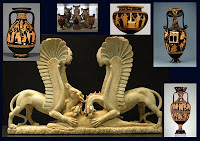The Rosetta Stone has a special, if not unique, place in the history of Egyptology. Its parallel texts allowed scholars to decipher ancient Egyptian hieroglyphs.
The inscription, dating to the second century BCE, was discovered by the French during the Napoleonic Wars when they were reconstructing a 15th century fort at Rosetta. The defeat of the French forces led to the seizure of archaeological finds as part of British war booty and the stone was put on display in the British Museum.
Dr Zahi Hawass has been
mounting a case for the return of the Rosetta Stone along with
other significant Egyptological pieces such as the head of
Nefertiti in Berlin.
Is there a legal case to return the Rosetta Stone? The benchmark international agreement is the
1970 UNESCO Convention on on the Means of Prohibiting and Preventing the Illicit Import, Export and Transfer of Ownership of Cultural Property. The United Kingdom became a signatory in
2002.
It should be noted that the UK has a statement about the interpretation of Clause 7 (b)(ii). The clause in the convention reads:
The States Parties to this Convention undertake:
...
(b) ...
(ii) at the request of the State Party of origin, to take appropriate steps to recover and return any such cultural property imported after the entry into force of this Convention in both States concerned, provided, however, that the requesting State shall pay just compensation to an innocent purchaser or to a person who has valid title to that property. Requests for recovery and return shall be made through diplomatic offices. The requesting Party shall furnish, at its expense, the documentation and other evidence necessary to establish its claim for recovery and return. The Parties shall impose no customs duties or other charges upon cultural property returned pursuant to this Article. All expenses incident to the return and delivery of the cultural property shall be borne by the requesting Party.
The UK interprets this as follows:
The United Kingdom interprets Article 7(b)(ii) to the effect that it may continue to apply its existing rules on limitation to claims made under this Article for the recovery and return of cultural objects.
Egypt has made a case for the return of recently looted (or "stolen") antiquities that appear to have surfaced after 1970. These include:
- The Third Intermediate Period coffin of Imesy seized in Miami and consigned by a Barcelona galerista.
- Two Middle Kingdom alabaster ducks apparently stolen from the Saqqara store and appearing with a major auction-house in New York and a dealer in London.
- The fragments from the tomb of Tetaky at Thebes (TT 15) acquired by the Louvre.
- A fragment from the tomb of Mutirdis (TT 410) that was due to be offered at auction in London.
- The head of Amenhotep III removed from Egypt by a British restorer.
- The eye from a statue of Amenhotep III returned from Switzerland.
Not all cases pursued by Egyptian authorities have been successful and there is an on-going request for the return of a mummy mask in the St Louis Art Museum (SLAM). Hawass claims that it was stolen from
the Saqqara store. Egypt has also been pursuing a number of antiquities dealers, and
an Australian national was detained in Egypt. One
recent case saw an unsuccessful detention in Sofia, Bulgaria; this appears to have been linked to
a larger case.
However, the Rosetta Stone was removed from Egypt long before 1970, and indeed well before
the creation of the modern independent state of Egypt.
This does not rule out voluntary returns of material that left Egypt before 1970. This would appear to include the
naos fragment of Amenemhat I that was returned from New York's Metropolitan Museum of Art (though the museum purchased it from the collector apparently to preserve their anonymity).
But should countries be denied the right to make claims on cultural property just because the objects were removed before the notional 1970 date? International law, and more importantly public museums, private collectors as well as dealers, need to respect
the local laws of the country concerned.
Egypt is arranging a
conference to discuss the return of cultural property in Cairo in the spring of 2010. And clearly the intention is to seek a solution for objects that Egypt deems to be important.
So where do I stand on the issue of the Rosetta Stone?
In a December 2009
interview I made the point that while (in my personal opinion) there is no legal case to be made, the Stone is so unique and central to the study of Egyptology that it should be displayed in Cairo:
“I would say that there is a very weak legal case to be made, but I think there is a very strong moral case to be made for this shortlist of significant objects to be displayed in Egypt ...
To me the argument is much more about ‘here is a unique icon of Egyptology, here is the stone that was used to unlock hieroglyphics’. It is so significant for the study of Egyptology that it’s more appropriate for it to be in Egypt,”
Could it be returned on loan? Does the title for the piece need to be given to Egypt? And there would be concern from some quarters about setting a "
dangerous precedent".
But this debate is so much more than a discussion of the ownership and display of cultural property. The real concern is the large-scale looting that feeds the international market in antiquities. This is the main area that needs to be addressed.
- For the Heritage Key debate on the Rosetta Stone click here.















